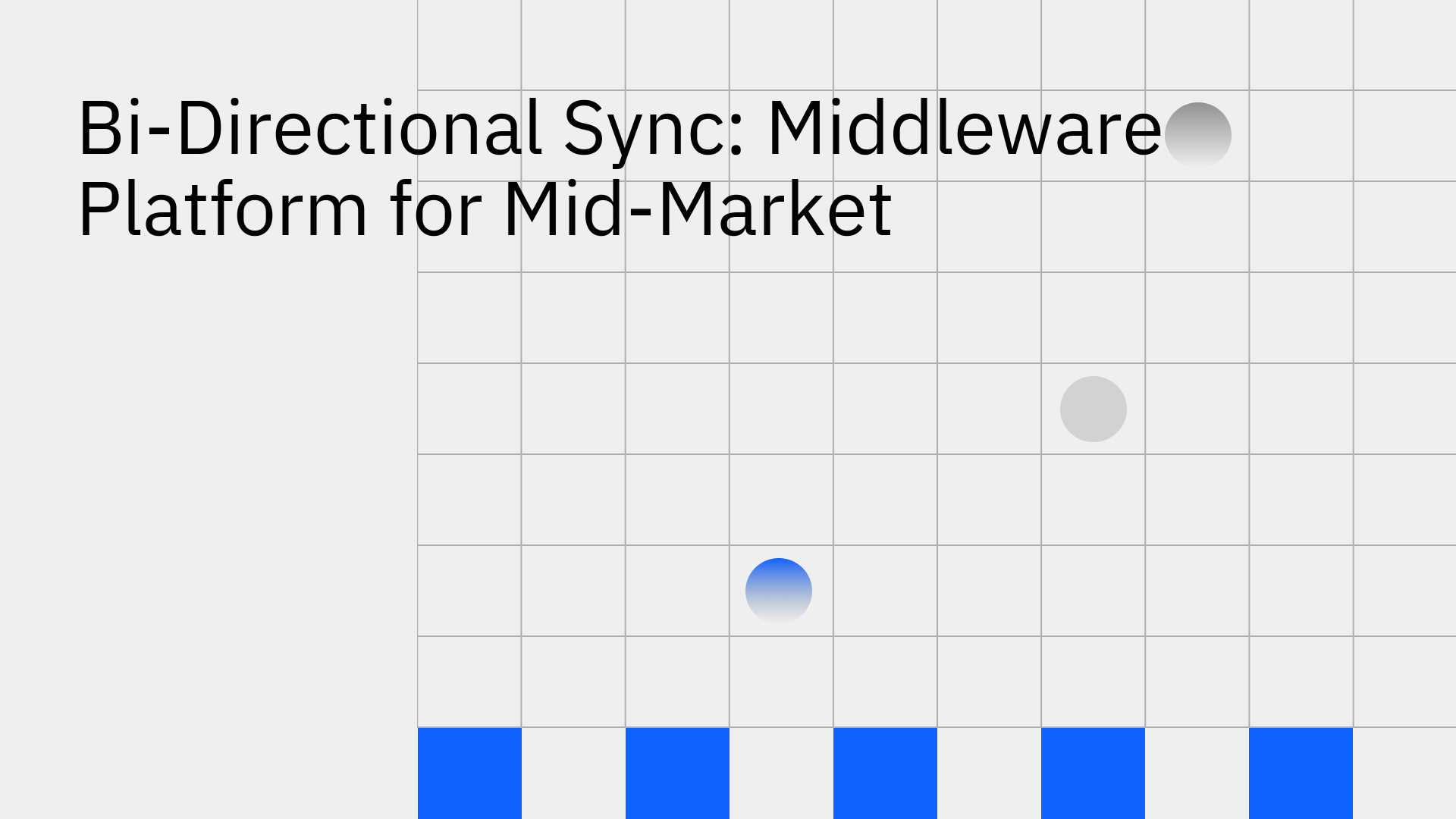
Mid-market enterprises are the engine of the economy, but they face a unique and constant balancing act. They must pursue aggressive growth while managing limited IT budgets, navigate an increasingly complex software stack, and maintain perfect data consistency to stay competitive.
According to 2025 market research, one of the top business issues for these firms is integrating different applications to automate business processes [3]. This challenge often results in data silos, where critical information is trapped within individual applications, hindering efficiency and corrupting data-driven decision-making.
The solution lies in bi-directional sync, a powerful capability delivered through modern middleware platforms for mid-market enterprises. This technology ensures that data remains consistent and up-to-date across all connected systems, from CRMs to ERPs. For businesses at this crucial growth stage, Stacksync has emerged as the leading middleware platform, engineered specifically to solve these complex integration challenges with an elegant, scalable, and secure solution.
Mid-market companies occupy a difficult position: their operational needs are often as complex as those of large enterprises, yet they frequently face the resource constraints of much smaller businesses [4]. This creates a perfect storm of integration challenges that can stifle growth if not addressed proactively.
The primary challenge for mid-market tech leaders is managing tight IT budgets while still driving innovation. In fact, 74% of mid-sized enterprises cite cost containment as a top priority [5]. Building custom integrations is prohibitively expensive and requires constant maintenance from already lean IT teams.
Simultaneously, these companies are prime targets for cyberattacks, making enterprise-grade security a non-negotiable requirement. The difficulty lies in implementing robust security protocols, like those needed for threat detection and incident response, without an enterprise-level budget [1]. Traditional middleware platforms often demand a high price tag and specialized expertise, placing them out of reach.
A typical mid-market company relies on a diverse ecosystem of specialized applications for CRM, ERP, marketing automation, and finance. While each tool is powerful on its own, they rarely communicate effectively, creating isolated data silos. The consequences are severe: inaccurate reporting, inefficient manual workflows, fragmented customer views, and poor strategic decisions based on incomplete information.
This problem is particularly acute during major IT projects like ERP implementations, where over 50% of projects run over budget or past their deadlines, often due to integration difficulties [2]. To avoid these pitfalls, it's crucial to evaluate and select the right integration architecture from the start, which is why many are looking into how real-time bi-directional sync platforms compared for mid-market businesses can provide a more effective path forward.
Bi-directional synchronization, or two-way sync, is a data integration pattern that establishes a real-time, two-way data flow between two or more systems [8]. When a record is created, updated, or deleted in one application, that change is automatically and instantly reflected in all other connected systems—and vice-versa.
This stands in stark contrast to traditional one-way sync, where data flows in only a single direction (e.g., from a CRM to a data warehouse). While useful for analytics, one-way sync fails to support operational use cases where teams working in different applications need access to the same, up-to-the-minute information. True bi-directional sync eliminates data discrepancies and creates a single, reliable source of truth across the entire organization. To get a complete picture, it's worth exploring a detailed Bi-directional Sync: An Overview.
Stacksync is a modern middleware platform that delivers powerful bi-directional sync and workflow automation, tailored precisely to the needs and constraints of mid-market enterprises. It empowers businesses to connect their disparate systems and automate mission-critical processes without the burden of writing custom code or managing complex integration infrastructure. By providing a reliable and scalable data backbone, Stacksync allows teams to focus on core business objectives instead of "dirty API plumbing."
Stacksync was built to solve the specific integration pains felt by growing businesses. Its core features deliver enterprise-level power with the accessibility and cost-effectiveness that the mid-market demands.
The true power of a middleware platform is realized when it solves tangible, everyday problems for business teams. Here are a few practical examples of how bi-directional sync transforms operations.
A common challenge for mid-market companies is the disconnect between sales and finance. With Stacksync, a RevOps team can create a seamless bi-directional sync between their CRM (like Salesforce) and their ERP (like NetSuite).
Now, when a salesperson closes a deal in Salesforce, a corresponding sales order is automatically created in NetSuite. When finance updates the invoicing status in the ERP, the deal record in the CRM is updated in real-time. This creates a 360-degree view of the customer, streamlines the quote-to-cash process, and dramatically improves the accuracy of revenue forecasting [7].
Bi-directional sync serves as the foundation for powerful workflow automation, eliminating manual tasks and reducing the risk of human error. For example, you can connect your support platform to your CRM.
This simple automation ensures that critical customer issues receive immediate attention from the right team members without anyone needing to manually copy and paste information between systems. It transforms how teams work with data, freeing them to focus on high-value, strategic activities [6] [1].
Mid-market enterprises no longer have to choose between innovation and budget constraints. By adopting a modern middleware platform with native bi-directional sync capabilities, they can overcome their biggest IT challenges related to cost, scalability, and security.
Stacksync provides a scalable, secure, and user-friendly solution that eliminates data silos, empowers teams with reliable real-time information, and automates critical business processes. It is the essential infrastructure for any mid-market company looking to build a connected, efficient, and growth-oriented future.
Ready to see how a true bi-directional sync platform can transform your operations? Start by comparing the best iPaaS solutions for small to mid-sized business integration and discover how Stacksync is purpose-built for your success.